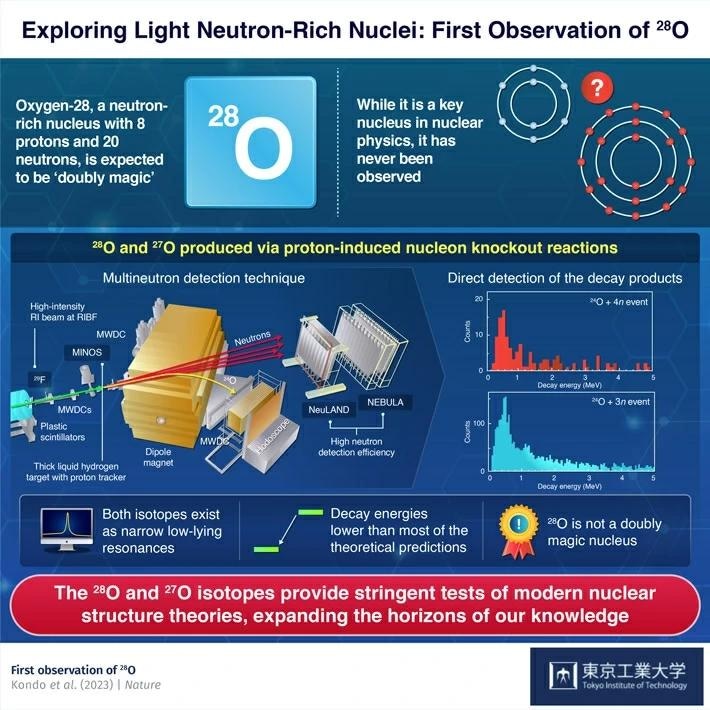According to experts from Tokyo Tech, the neutron-rich oxygen isotopes oxygen-27 and oxygen-28 exist as extremely short-lived resonances, according to the first observation of their disintegration into oxygen-24 and three and four neutrons, respectively. Notably, the oxygen-28 nucleus is discovered to be “doubly magic,” contrary to what is predicted in the typical shell-model image. The study gives important information on the nuclear structure.

Image Credit: Tokyo Institute of Technology
The investigation of physical systems under severe circumstances provides important insights into their organization and structure. In nuclear physics, neutron-rich isotopes, particularly those with a neutron-to-proton ratio that differs greatly from stable nuclei, present rigorous tests of contemporary nuclear structure theories. These isotopes exist as extremely short-lived resonances that decay by spontaneous neutron emission.
The initial observation of two such isotopes, oxygen-28 (28O) and oxygen-27 (27O), through their decay into oxygen-24 with four and three neutrons, respectively, has now been reported by an international team of researchers in a study that has been published in Nature and is led by Yosuke Kondo, an Assistant Professor at the Department of Physics at Tokyo Institute of Technology.
As one of the few “doubly magic” nuclei in the conventional shell-model interpretation of nuclear structure, the nucleus 28O, which has 8 protons and 20 neutrons (N), is of considerable interest.
The RIKEN RI Beam Factory’s skills, which could generate powerful beams of unstable nuclei connected to an active target of thick liquid hydrogen and multi-neutron detection arrays, were essential to the study’s success. The neutron-unbound isotopes 27O and 28O were produced by proton-induced nucleon knockout reactions from a high-energy 29F beam. By directly seeing the decay products of these isotopes, the researchers could examine and learn more about them.
They discovered that 27O and 28O both exist as narrow low-lying resonances and compared their decay energies to the outcomes of complex theoretical models based on efficient field theories of quantum chromodynamics. These models included a large-scale shell model computation and a newly devised statistical technique.
Specifically, the statistical coupled-cluster calculations suggested that the energies of 27O and 28O can provide valuable constraints for the interactions considered in such ab initio approaches.
Dr. Yosuke Kondo, Assistant Professor, Department of Physics, Tokyo Institute of Technology
The cross-section for creating 28O from the 29F beam was also examined, and the researchers discovered that it was consistent with 28O not displaying a closed N = 20 shell shape.
Dr. Kondo added, “This result suggests that the ‘island of inversion,’ whereby the energy gap between neutron orbitals weakens or vanishes, extends beyond the fluorine isotopes 28F and 29F into the oxygen isotopes.”
The new discoveries contribute to the understanding of nuclear structure by providing fresh insights, particularly for extremely neutron-rich nuclei. Furthermore, the multi-neutron-decay spectroscopy approach used here allows for extensive research of multi-neutron correlations as well as the study of other unusual systems.
Further investigation is expected to reveal many more mysteries of nuclei
Journal Reference:
Kondo, Y., et al. (2023) First observation of 28O. Nature. doi:10.1038/s41586-023-06352-6